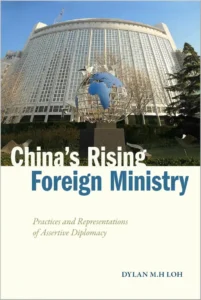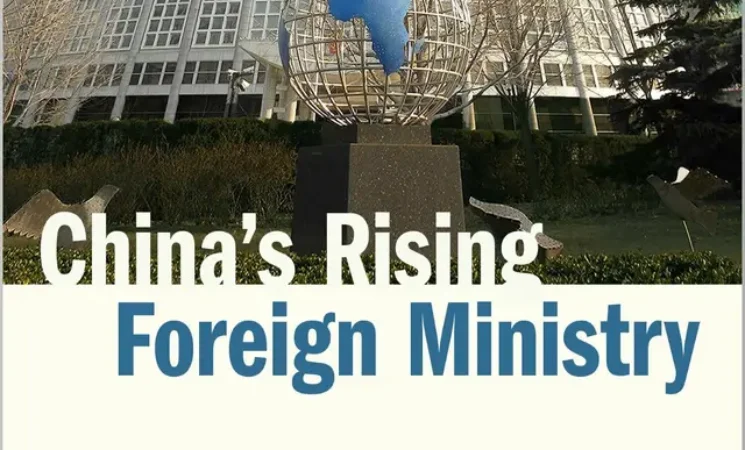Dylan M.H. Loh (2024), China’s rising foreign ministry: Practices and representations of assertive diplomacy, Stanford, CA: Stanford University Press.
Manoj Karki
 Dylan Moh, through his China’s rising foreign ministry: Practices and representations of assertive diplomacy, is motivated by the “practice turn” – an analytical inquiry focusing on human/institutional “doings and sayings” (p. 2). This book seeks to extend the knowledge of the “practice turn in IR to examine Chinese diplomacy, particularly its assertive diplomatic shift from 2009 to 2020” (p. 2). Loh argues that “Chinese assertiveness has increasingly come to be represented by the Chinese diplomats and Ministry of Foreign Affairs (hereafter MFA) – so much so that MFA is now the central driver and representation of ‘assertive China’ meme” (p. 2).
Dylan Moh, through his China’s rising foreign ministry: Practices and representations of assertive diplomacy, is motivated by the “practice turn” – an analytical inquiry focusing on human/institutional “doings and sayings” (p. 2). This book seeks to extend the knowledge of the “practice turn in IR to examine Chinese diplomacy, particularly its assertive diplomatic shift from 2009 to 2020” (p. 2). Loh argues that “Chinese assertiveness has increasingly come to be represented by the Chinese diplomats and Ministry of Foreign Affairs (hereafter MFA) – so much so that MFA is now the central driver and representation of ‘assertive China’ meme” (p. 2).
This book provides a rich contribution to recent diplomatic studies and IR scholarship. The book provides both theoretical, which is driven by the careful application and development of Bourdieusian practice theory, and empirical, as Loh goes beyond the preponderance of existing (practice theoretical) scholarship on the Western case studies in detail to explore the diplomatic practices that make (and are made by) MFA. Following its title, the book tackles and newly explains the much-proclaimed ‘rise’ of China through an analysis of changes in the political profile, funding, structure, composition, and most importantly, assertiveness of its Ministry of Foreign Affairs, focusing on the years 2009-2020. To understand China’s rising position internationally, Loh argues from the outset that we need to understand how ‘assertiveness’ is made in practice. Loh defines PRC assertiveness as “the tendency to use its power and influence to impose costs on others to extract compliance and/or police behavior” (p. 2), with a subset of what he calls “diplomatic assertiveness” defined as “using various diplomatic levers to extract concessions, police behavior, and impose costs” (p. 16).
Mobilizing a practice approach (which he explains in great detail in Chapter One, ‘Chinese Foreign Policy, MOFA’s Role, and the “Practice Turn”’ and in such a pedagogically useful way that it may well become a stand-alone required reading in any IR theory course), Loh asks — and answers — the following questions: How is China’s assertiveness represented, and what are its concrete manifestations? Why has Chinese behaviour on the international stage been increasingly evaluated by different international actors and publics as assertive? How do other state actors construct and understand Chinese foreign policy behaviour? (p. 2/3).
The analytical chapters are a pleasure to read. On the one hand, because Loh is so successful in grounding China’s ‘assertive rise’ in relatable micro-practices like finger wagging, staring and condescending looks (p. 47/48), scheduling meetings (p. 59/82), disinviting other parties from meetings (p. 140), always showing up with a colleague (p. 110), or the pulling out of a piece of paper from conference information packs (p. 88). On the other hand, he never loses sight of the theoretical, conceptual, and political relevance of such everyday activities. The result on the page is paragraphs in which Bourdieu and Vincent Pouliot are constantly evoked in close proximity to a direct quote from a Chinese diplomat or Ministry of Foreign Affairs affiliate in order to make immediate academic sense of their ‘sayings and doings.’ As the text proceeds, the theoretical framework never disappears in the rearview mirror, and Loh shows practice theory at its best by keeping the theorist and practitioner constantly in touch.
While understanding MFA’s growing representation in China’s diplomacy is important, this role has limits. Overestimating MFA’s influence needs to be avoided, as it is, in essence, an implementer of foreign policies made by Chinese top leaders. At present, “President Xi Takes Control” (p. 77). This is reflected in the diplomatic concepts and strategies such as the “Community of Common Destiny,” BRI, and the Global Development/Security/Civilisation initiatives coined by Xi. Their promotion is MFA’s top priority.
Loh cites, as evidence of MFA’s growing influence, the growing job rotation opportunities for MFA diplomats as senior officials, such as deputy governor, mayor, or deputy mayor in local governments. However, this is offset by the growing number of non-MFA officials appointed as ambassadors overseas. Similarly, Loh points out that political loyalty is the first criterion in MFA’s staff recruitment. While important, this is a continuation of MFA’s old tradition. Back in 1951, Premier and Foreign Minister Zhou Enlai instructed Chinese diplomats to “stand firm in China’s position.’’
Looking into the near future, it is likely that MFA will continue to perform assertive “practices that persuade, threaten, and coerce’ (p. 56). This could further damage China’s image abroad, as “for non-Chinese diplomats, an assertive Chinese diplomat is an assertive China” (p. 138). What’s more, as the geostrategic competition between China and traditional powers intensifies, engagement between Chinese actors such as the military and companies with the West will decline. This will provide more opportunities for MFA’s representation, which is worthy of scrutiny.
I found some interesting facts about China’s Ministry of Foreign Affairs and its diplomatic practices, which I thought would be worth writing here. Let me begin point-wise:
- “MFA was founded in September 1954 (Ministry of Foreign Affairs, 2013), after the establishment of the PRC in 1949” (p. 104). Its predecessor was the Central People’s Government Ministry of Foreign Affairs (1949).
- The room for the MFA press briefings is called the ‘Blue Hall,’ originally built for hosting conferences (Ministry of Foreign Affairs, 2011). The Blue Hall is the site of press briefings of the MFA since 2011.
- “In the past, no one cared about what a Chinese vice foreign minister said. Now, what a vice foreign minister says will move financial markets around the world” (Interviewee 77, personal communication, November 16, 2018) (p. 40)
- “Starting from around 2019, China started to use Twitter to convey its diplomatic messages and activities: the number of official Chinese diplomatic Twitter accounts multiplied to over eighty in 2020, compared to an initial seventeen in October 2018” (The Economist, 2020) (p. 119)
- “We have requested personnel to assist. The two Chinese tourists will go to FRO for certain procedures. Friends familiar with FRO should also help” (Zha, 2019) (p. 127)
Note: Dylan innocently infers that “FRO” refers to part of the embassy. But thanks to Elon Musk’s Grok AI, I could tease out what “FRO” meant in the above tweet. FRO or FRRO (for regional branches) stands for Foreigners Registration Office, an Indian government agency handling immigration-related functions, including visa extensions and registrations.
Manoj Karki has recently completed his Master’s from the School of International Studies, Jawaharlal Nehru University, and is currently working as a Research Assistant to Sri Kamakhya Prasad Tasa, Member of Parliament, Lok Sabha, India.

